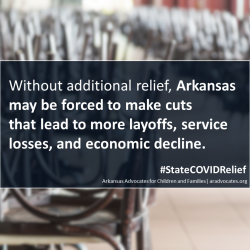
States are nearing shortfalls that could be the largest on record – totaling over $500 billion in just over a fiscal year
While federal policymakers have provided a substantial amount of fiscal relief to state and local governments to combat the COVID-19 pandemic, Arkansas and other states need much more in order to avoid spending cuts that would harm families, destabilize communities and deepen the recession, according to a new report from the Center on Budget and Policy Priorities. In the coming months, Arkansas’ revenues are expected to plummet – all while health, unemployment, and other costs related to the virus soar and begin to deplete the state’s inadequate reserves.
Arkansans are already losing their jobs and businesses, as they’re also fearing for their health and lives. And the situation will worsen when our state revenues plummet and containment of the virus leads to a spike in public costs. Absent swift and significantly more federal assistance, Arkansas will be forced to make dramatic spending cuts that hurt families, drive up inequality, and slow the broader economic recovery.
Even after accounting for the federal fiscal aid (the CARES Act) and states’ rainy day funds, states still face shortfalls of as much as $360 billion, not including the substantial new costs they face to combat the COVID-19 virus. After the Great Recession, states and localities made $290 billion in cuts that worsened racial and class inequities and slowed the recovery.
“The Medicaid increase and Coronavirus Relief Fund were important first steps, but they fall far short. States need more to respond to their worsening budget problems and protect their residents,” explained report coauthor Elizabeth McNichol, Senior Fellow at the Center on Budget and Policy Priorities. “This recession is projected to be considerably deeper than the last one. If states don’t get substantially more relief, they will balance their budgets with cuts that damage education, unemployment systems, infrastructure, and other critical public investments for years to come.”
In the next round of aid, federal lawmakers should provide additional Medicaid funding and/or other forms of fiscal relief to states by:
- Further increasing the federal government’s share of Medicaid payments (FMAP); this increase should adjust with economic conditions and remain in place as long as unemployment remains high
- Providing additional fiscal relief through an extended and/or flexible Coronavirus Relief Fund or other means
- Providing some aid to local governments as well
